Rajasthan Board RBSE Class 12 Economics Chapter 3 Concept of Demand
RBSE Class 12 Economics Chapter 3 Practice Questions
RBSE Class 12 Economics Chapter 3 Multiple Choice Questions
Question 1.
Demand for a commodity shows a relationship between quantity demanded and its prices.
(a) positive
(b) infinite
(c) zero
(d) inverse
Answer:
(d)
Question 2.
Market demand is summation of individual demand curve.
(a) horizontal
(b) vertical
(c) diagonal
(d) None of the above
Answer:
(a)
Question 3.
Extension and contraction of demand is due to the :
(a) Change in the price of the commodity itself
(b) Change in the price of other commodities
(c) Change in taste and preferences of consumers
(d) Change in income of consumers
Answer:
(a)
Question 4.
If demand function of a commodity is Dx = 35 – 4 (Px) and its price is ₹ 5 per unit, the demand would be :
(a) 20
(b) 15
(c) 35
(d) 0
Answer:
(b)
Question 5.
On ‘what type of goods, law of demand does not apply?
(a) Giffen goods
(b) Normal goods
(c) Substitute goods
(d) Complementary goods
Answer:
(a)
RBSE Class 12 Economics Chapter 3 Very Short Answer Type Questions
Question 1.
What are giffen goods?
Answer:
Giffen goods are those goods whose demand increases when the price of commodity increases, and demand’decreases when the price of commodity decreases.
Question 2.
Define law of demand.
Answer:
According to the law of demand, “Other things being equal, if the price of a commodity falls, the quantity demanded of it will rise, and if the price of the commodity rises, its quantity demanded will decline.”
Question 3.
How is market demand curve obtained from individual demand curves ?
Answer:
Market demand curve is the horizontal summation of individual demand curves.
Question 4.
Due to increase in income of a consumer, if he increases the quantity demand, then what type of goods is it?
Answer:
Luxury goods.
Question 5.
If demand curve shifts leftwards due to increased income, then what will it be called?
Answer:
Decrease in demand.
RBSE Class 12 Economics Chapter 3 Short Answer Type Questions
Question 1.
Explain diagrammatically the movement along a demand curve and shift in demand curve.
Answer:
Movement along a demand curve is of two types:
(i) Extension of Demand : Extension of demand is shown by the table given below and curves. When the price of chocolate is ₹ 5, one chocolate is demanded. When price reduces to ₹ 1, demand extends to 5 chocolates.
| Price (in ₹) | Quantity (Units) | Description |
| 5 | 1 | Fall in price |
| 1 | 5 | Rise in quantity demanded |
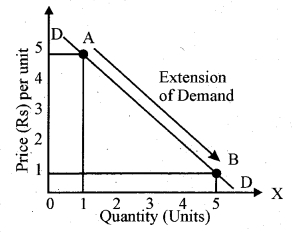
Extension of demand is indicated by a movement along the same demand curve, as from point A to B on the demand curve-D.
(ii) Contraction of Demand: Contraction of demand is shown with the help of table and given below curve, when the price of chocolate is ₹ 1 per chocolate, demand is for 5 chocolates; when price rises from ₹ 1 to ₹ 5 per unit, demand contracts to 1 chocolate only.
| Price (in₹) | Quantity (Units) | Description |
| 1 | 5 | Rise in price |
| 5 | 1 | Fall in quantity demanded |
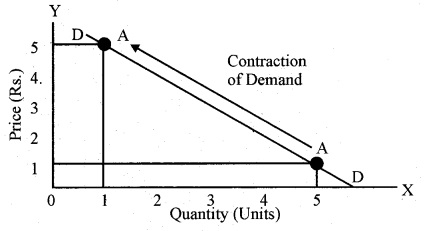
Contraction of demand is also indicated by a movement along the same demand curve.
Shift in demand curve is of two types:
(i) Increase in Demand : Increase in demand shows that when more of a commodity is purchased at its existing price, (when prices of chocolate is ₹ 10), then demand of chocolate is 20 units, but if the price is constant, then the demand increases to 30 units. It is better understood by the given below table and curve :
| Price (in ₹) | Quantity Demanded (Units) |
| 10 | 20 |
| 10 | 30 |
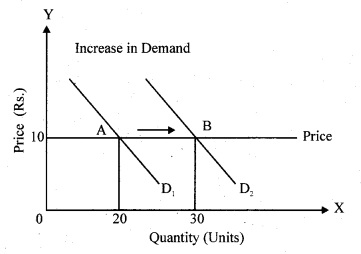
Demand curve shifts from D1 to D2 when the consumers decide to purchase 30 units (instead of 20) even when price of the commodity remains constant at ₹ 10 per unit. The consumer shifts from point A on D1 to point B on D2.
(ii) Decrease in Demand : Decrease in demand is the condition in which less of a commodity is purchased at its existing price. If the price of commodity is ₹ 10 per unit, 30 units are demanded. Even, when price remains constant, consumers decide to buy only 20 units.
| Price (in ₹) | Quantity Demanded (Units) |
| 10 | 30 |
| 10 | 20 |
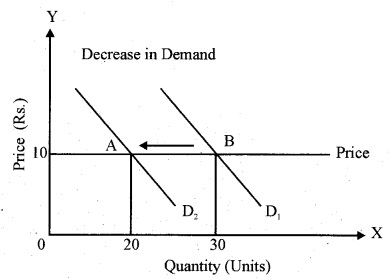
The decrease in demand causes the demand curve to shift on the left, which is also called the Backward shift in the Demand Curve.
Question 2.
Differentiate between normal goods and inferior goods.
Answer:
Normal goods are those goods whose demand increases when the income of a consumer increases and demand decreases when the income decreases, while the price of the goods remains unchanged. Example- wheat, grains, sugar, branded clothes, etc.
Inferior goods are those goods whose demand decreases when the income of a consumer increases. Examples of inferior goods are consumption of breads or cereals and since the income of the consumer increases he moves towards consumption of more nutritious foods and hence demand for low-priced products like bread or cereal, decreases.
Question 3.
If X is a commodity and Y is its substitute commodity, then what will be the effect of decrease in the price of Y commodity on the demand for commodity X ? Explain with the help of a diagram.
Answer:
In substitution effect, the commodity that becomes cheaper, can be substituted for relatively expensive commodity. If the price of commodity Y decreases, then the demand for commodity X will reduce, since consumer will substitute commodity Y in place of commodity X.
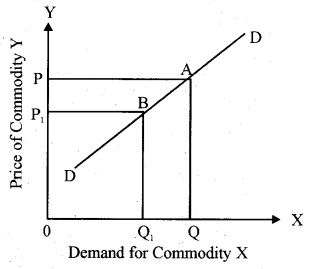
It is clear from the figure that when the price of commodity Y was OP the demand for commodity X was OQ When the price of commodity Y decreases to OP1 the demand for commodity X becomes OQ1 The demand curve for substitution goods is positive.
RBSE Class 12 Economics Chapter 3 Essay Type Questions
Question 1.
Explain the law of demand with the help of schedule and diagram.
Answer:
The law of demand describes that, other things being equal, the demand for a good extends with a decrease in price and contracts with an increase in price. There is an inverse relationship between quantity demanded of a commodity and its price, provided other factors influencing demand remain unchanged.
Law of demand can be explained with the help of demand schedules and demand curve:
Demand Schedule
| Price (in ₹) Px | Quantity Demanded (Units) Qx |
| 6 | 100 |
| 5 | 200 |
| 4 | 300 |
The schedule shows extension of demand in response to decrease in price of the commodity. Thus, demand stretches from 100 to 200 units when price declines from ₹ 6 to ₹ 5 per unit, and from 200 to 300 units when price further declines from ₹ 5 to ₹ 4. This can be clarified with the help of adjoining demand curve.
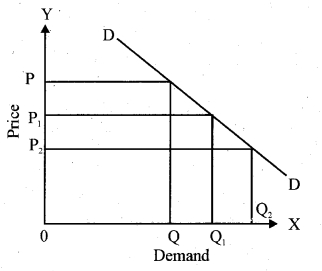
Question 2.
Differentiate between change in demand and change in quantity demanded for a demand curve.
Answer:
If other things remain constant, then change in quantity demanded means the increase or decrease in quantity purchased of a commodity in response to decrease or increase in its price. It is manifested through movement along the demand curve. Change in demand, on the other hand, refers to increase or decrease in quantity demanded of a commodity in reaction to change in other determinants of demand other than price of the same commodity. It is expressed through shifts in demand curve – forward shift or backward shift.
(i) Movement Along a Demand Curve or Change in Quantity Demanded : When the quantity demanded of a commodity changes due to the change in its price only, it is expressed by different points on the same demand curve and it is known as Movement Along a Demand Curve or Change in Quantity Demanded. It is of two types:
(a) Extension-of Demand : When the quantity demanded of a good rises due to the fall in price, while other things remaining constant, it is called Extension of Demand. Extension of demand is shown by the given below table and curve, when the price of chocolate is ₹ 5, one chocolate is demanded. When price reduces to ₹ 1, demand extends to 5 chocolates.
| Price (in ₹) | Quantity (Units) | Description |
| 5 | 1 | Fall in price |
| 1 | 5 | Rise in quantity demanded |
Extension of demand is indicated by a movement along the same demand curve, as from point A to B on the demand curve-D-D’.
(b) Contraction of Demand : When the quantity demanded falls due to the rise in price, it is called Contraction of Demand. Contraction of demand is shown with the help of table and given below curve, when the price of chocolate is ₹ 1 per chocolate, demand is for 5 chocolates; when price rises from ₹ 1 to ₹ 5 per unit, demand contracts to 1 chocolate only.
| Price (in ₹) | Quantity (Units) | Description |
| 1 | 5 | Rice in price |
| 5 | 1 | Fall in quantity demanded |
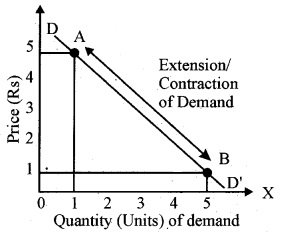
Contraction of demand is also indicated by a movement along the same demand curve from B to A on demand curve DD’.
(ii) Shifting of the Demand Curve or Changes in Demand : In this condition, the whole demand curve shifts either upward or downward. When quantity demanded changes due to the change in variables other than the price of the same commodity, it is called Change in Demand. Example – income, fashion, etc. When the demand decreasees due to the change in other variables, it is called Decrease in Demand and when the demand increases due to the change in other variables, it is called Increase in Demand.
(a) Increase in Demand : When more of a goods is purchased at its current price, it is a situation of increase in demand. It is illustrated by the given figure. Increase in demand shows that more of a commodity is purchased at its existing price, when prices of chocolate is ? 10, then demand of chocolate is 20 emits, but if the price is constant, then the demand is increases to 30 units. It is better understood by the given below table and curve:
| Price (in ₹) | Quantity Demanded (Units) |
| 10 | 20 |
| 10 | 30 |
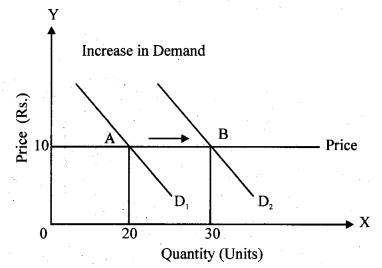
Demand curve shifts from D1 to D2 when the consumers decide to purchase 30 units (instead of 20) even when price of the commodity remains constant at ₹ 10 per unit. The consumer shifts from point A on D1 to point B on D2. This is also called the forward shift in Demand curve.
(b) Decrease in Demand : It is the condition in which when less of a commodity is purchased at its existing price. If the price of commodity is ₹ 10 per unit, 30 units are demanded. Even, when price remains constant, consumers decide to buy only 20 units.
| Price (in ₹) | Quantity Demanded (Units) |
| 10 | 30 |
| 10 | 20 |
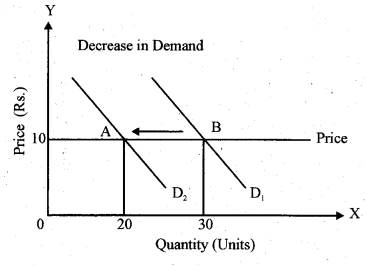
The decrease in demand is due to changes in the demdnd curve on the left, which is also called the Backward shift in the Demand Curve.
Question 3.
Explain the effects on demand of a commodity due to:
(i) Increase in income
(ii) Increase in prices of related goods
Answer:
(i) Increase in Income :
If the other things, that is, determinants of demand other than price such as consumer’s taste and preferences, income, prices of the related goods change, the entire demand curve will be changed. If our income rises, we tend to purchase more of commodities. Our tendency to purchase is increased when income increases. This will mean more branded clothes, more visits to a restaurant, more shopping and so on. Thus, as a result of increase in demand, the whole demand curve will shift outward, that is, to the right.
If there are other factors, which are determinants of demand besides the consumer’s taste and prices, changes in prices, changes in the value of related items, then the entire demand curve will change. If our income increases, then we buy more items. Our tendency is that increased income will mean more branded clothes, more visits to a restaurant, more shopping and so on. In this way, the increase in demand will result in a complete change demand curve, which is correct.
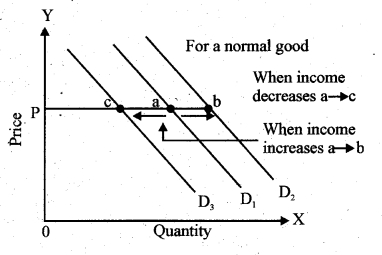
In the case of increase in income, more of a (normal) good is purchased even when its price is stable. It reflects to a situation of increase in demand or forward shift in demand curve. On the other hand, in this condition of decrease in income, less of a (normal) good is purchased even when its price is constant. This refers to a situation of decrease in demand or backward shift in demand curve.
(ii) Increases in Price of Related
Goods : The impact of change in the price of related good on a demand of commodity is called the Cross-Price Effect. The figure indicates that when the price of tea is OP1 the quantity purchased is OT1 Now, suppose the price of tea is stable but the price of cbffee increases. How will you respond as a consumer?
As a logical consumer, you can choose some tea instead of coffee. Or, you expect to buy more tea when your price is stable. This is reflected in the following diagram –
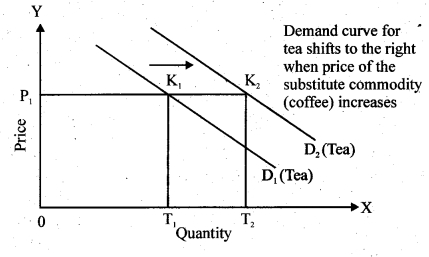
Initially you were purchasing OT1 quantity of tea = P1K1. Now you are ready to purchase OT2 = P1K2 even when price of tea remains stable at OP1 Greater purchase of a commodity at its constant price points to a situation of increase in demand, or forward shift in demand curve. Accordingly, demand curve for tea shifts to the right, from D1 to D2.
RBSE Class 12 Economics Chapter 3 Other Important Questions – Answers
RBSE Class 12 Economics Chapter 3 Multiple-Choice Questions
Question 1.
Demand for a commodity refers to :
(a) desire for the commodity
(b) need for the commodity
(c) quantity demanded of that commodity
(d) quantity of the commodity demanded at a certain price during any particular period of time
Answer:
(d)
Question 2.
Contraction of demand is the result of :
(a) decrease in the number of Consumers .
(b) increase in the price of the good concerned
(c) decrease in the prices of other goods
(d) decrease in the income of purchasers
Answer:
(b)
Question 3.
All but one of the following are assumed to remain the same while drawing an individual’s demand curve for a commodity. Which one is it?
(a) The preference of the individual
(b) His monetary income
(c) Price
(d) Price of related goods
Answer:
(c)
Question 4.
Which of the following pairs of goods is an example of substitutes?
(a) Tea and Sugar
(b) Tea and Coffee
(c) Pen and Ink
(d) Shirt and Trousers
Answer:
(b)
Question 5.
The law of demand, assuming other things to remain constant, establishes the relationship between :
(a) income of the consumer and the quantity of a good demanded by him
(b) price of a good and the quantity demanded
(c) price of a good and the demand for its substitute
(d) quantity demanded of a good and the relative prices of its complementary goods
Answer:
(b)
Question 6.
If regardless of changes in its price, the quantity demanded of a good remains unchanged, then the demand curve for the good will be :
(a) horizontal
(b) vertical
(c) positively sloped
(d) negatively sloped
Answer:
(b)
Question 7.
The law of demand is :
(a) a quantitative statement
(b) a qualitative statement
(c) both a quantitative and a qualitative statement
(d) neither a quantitative nor a qualitative statement
Answer:
(b)
Question 8.
All of the following are determinants of demand except:
(a) tastes and preferences
(b) quantity, supplied
(c) income
(d) price of related goods
Answer:
(b)
Question 9.
A movement along the demand curve for soft drinks is best described as :
(a) an increase in demand
(b) a decrease in demand
(c) a change in quantity demanded
(d) a change in demand
Answer:
(c)
Question 10.
If the price of Pepsi decreases relative to the price of Coke and 7-UP, the demand for :
(a) Coke will decrease
(b) 7-UP will decrease
(c) Coke and 7-UP will increase
(d) Coke and 7-UP will decrease
Answer:
(d)
Question 11.
According to ……………. “Law of Demand states people will buy more at lower prices and buy less at higher prices, other things remaining the same
(a) Prof. Marshall
(b) Prof. Ferguson
(c) Prof. Samuelson
(d) Bilas
Answer:
(c)
Question 12.
Goods having negative price effect and positive income-effect are known as :
(a) inferior goods
(b) normal goods
(c) substitute goods
(d) complementary goods
Answer:
(b)
Question 13.
Goods having negative income effect are termed as :
(a) inferior goods
(b) normal goods
(c) substitute goods
(d) complementary goods
Answer:
(a)
Question 14.
Inferior goods having negative income effect and positive price effect are called …………………… goods.
(a) inferior goods
(b) giffen goods
(c) substitute goods
(d) complementary goods
Answer:
(b)
Question 15.
Goods jointly consumed or collectively satisfying our wants are known as :
(a) inferior goods
(b) normal goods
(c) substitute goods
(d) complementary goods
Answer:
(d)
Question 16.
Goods used in place of each other are :
(a) inferior goods
(b) normal goods
(c) substitute goods
(d) complementary goods
Answer:
(c)
Question 17.
An individual demand curve slopes downward to the right because :
(a) income effect of fall in price
(b) substitution effect of decrease in price
(c) diminishing marginal utility
(d) All of the above
Answer:
(d)
Question 18.
A giffen good is one whose demand increases, other things remaining the same, when :
(a) its price increase
(b) consumer’s income increases
(c) price of its superior substitutes decreases
(d) None of these
Answer:
(a)
Question 19.
An upward shift in the demand curve for a product is caused by which of the following ?
(a) Decrease in price of the products
(b) Increase in consumer’s income
(c) Fall in the price of substitutes
(d) None of the above
Answer:
(b)
Question 20.
Market demand is :
(a) Horizontal summation of individual’s demand in the market
(b) Vertical summation of individual’s demand in the market
(c) Diagonal summation of individual’s demand in the market
(d) Multiplication of individual’s demand in the market with price
Answer:
(a)
Question 21.
Which of the following can be regarded as an exception to the law of demand?
(a) Cases of snob appeal (e.gjewels)
(b) Cases in which consumer judges quality by price
(c) Cases of giffen goods
(d) All of the above
Answer:
(d)
RBSE Class 12 Economics Chapter 3 Very Short Answer Type Questions
Question 1.
What is meant by demand?
Answer:
Quantity of goods and services, which consumers would buy in a market at a given price in certain period is known as Demand.
Question 2.
Mention two factors which influence the demand for a commodity.
Answer:
Two factors which influence the demand for a commodity are income of the consumer and price of a commodity.
Question 3.
What is a demand curve?
Answer:
The demand curve is a graphical statement or representation of quantities of a good which will be demanded by the consumer at various possible prices in a period of time.
Question 4.
Explain the circumstances in which demand curve slopes upwards.
Answer:
When a demand of a commodity increases with the rise in its price and demand of a commodity decreases with the fall in its price, the demand curve will slope upward due to this similar directional changes.
Question 5.
Name two determinants of demand.
Answer:
- Tastes and preferences
- Income of the buyer.
Question 6.
What is meant by law of demand?
Answer:
If the other things remaining the same, then increase in demand due to decrease in price and decrease in demand due to increase in price is termed as Law of Demand.
Question 7.
Why does the demand curve slope downwards?
Answer:
Demand curve slopes downwards because of :
- Law of diminishing marginal utility
- Income effect
- Substitution Effect
- New consumers
- Different alternative uses of product.
Question 8.
What is the slope of demand curve for giffen goods?
Answer:
The position of slope of demand curve for giffen goods is upward.
Question 9.
What is demand schedule?
Answer:
Demand schedule is that schedule which, other things remaining constant, expresses the relation between different quantities of the commodity demanded at different prices.
Question 10.
What is meant by extension of demand?
Answer:
Other things being equal, when with a fall in price, quantity demanded of a commodity rises, its called Extension of Demand.
Question 11.
What is meant by contraction of demand?
Answer:
Other things remaining the same, when with a rise in price, quantity demanded of a commodity decreases, it is called Contraction of Demand.
Question 12.
What is meant by complementary goods?
Answer:
Complementary means a product that is associated with another product and can be used together only, or such goods which are jointly consumed.
Question 13.
Give examples of complementary goods.
Answer:
- Pen and ink
- Bread and butter
Question 14.
What do you understand by substitute goods?
Answer:
When two goods are used as the alternative of one another, they are called Substitute Goods.
Question 15.
Mention arty one determinant of demand for a commodity other than its price.
Answer:
Expectation.
Question 16.
If the quantity demanded of commodity X decreases as the household income increases, what type of good is X?
Answer:
Inferior goods.
Question 17.
If the demand for good Y increases as price of another good X rises, how are the two goods related?
Answer:
X and Y are substitute goods.
Question 18.
What happens to the demand for a substitute good of a commodity when the price of the commodity falls/rises?
Answer:
If the price of one commodity falls, then the demand of other commodity decreases, in contrast, when the price of one commodity rises, then the demand of other commodity increases.
Question 19.
Why does the demand for coffee increase when the price of tea increases?
Answer:
Because coffee is the substitute of tea, if the price of tea increases, then public will prefer to take coffee in view of increased tea price.
Question 20.
Why does the demand for ink increase when the price of pen falls?
Answer:
Because ink is a complementary product of pen. Demand of ink depends on the demand of pen, if price of pen falls, then demand of pen will increase and if the demand of pen increases, then it is sure that demand of ink will be increased. Both are complementary goods.
Question 21.
What does movement on the same demand curve show?
Answer:
Movement along a demand curve indicates a change in quantity demand in response a change in the commodity’s own price.
Question 22.
What does the shifting of a demand curve show?
Answer:
A shift in demand curve indicates a change in demand in response to a change in determinant of demand (like income, price of the goods, tastes, expectations, etc.) other than commodity’s own price.
Question 23.
If the demand of CNG increases as price of petrol increases, how are these two goods related?
Answer:
Two goods are substitute goods, here CNG is the substitute of petrol.
Question 24.
How is the demand for a complementary good affected by the increase in the price of its related good?
Answer:
The demand for a complementary good increases, if the price of its related good deccreases.
Question 25.
Define market demand.
Answer:
The sum total of individual demands is known as Market Demand.
Question 26.
How is the market demand affected by unequal distribution of income?
Answer:
If the income is distributed unequally, then the demand for essential commodities will be the more whereas the demand for other kinds of goods will be relatively less.
Question 27.
What is the relation between income of a consumer and the demand for a good that he consumes?
Answer:
A change in the income of the consumer significantly influences his demand for most commodities and thus demand for goods in general increases with a rise in the consumer’s income.
Question 28.
When is a good called a ‘normal good’?
Answer:
Normal goods are the goods the demand for which increases as income of the buyer rises and there is a positive relationship between income and demand.
Question 29.
When is a good called a ‘inferior good’?
Answer:
Goods whose demand decreases when the income of consumer increases, are called ‘Inferior Goods.’
RBSE Class 12 Economics Chapter 3 Short Answer Type Questions (SA-I)
Question 1.
How many elements of demand are there for a commodity?
Answer:
There are three elements of demand for a commodity. These are:
- Desire for a commodity.
- Money to fulfil that desire.
- Readiness to spend money.
Question 2.
What are the different uses of the commodity?
Answer:
Commodities have many uses. If their price rises, they are used only for more important purposes. As a result, their demand will go down. On the contrary, when the price is reduced, they will be put to different uses and their demand will rise. For example, with the increases in the electricity charges, power will be used primarily for domestic lighting, but if the charges are reduced, people will use power for cooking, fans, heaters, etc.
Question 3.
What is meant by ‘substitution effect’?
Answer:
When the price of the commodity falls, then the consumer replaces the object which has now become relatively dear, with other objects. If the price of tea falls, it will be used by some people in place of other beverages to some extent. The reason is not far to seek, when the price of a commodity falls, the consumer’s marginal utility for that commodity becomes comparatively high. Hence to increase his total satisfaction, he finds it worthwhile to purchase more of the cheaper commodity as against the dearer one. In contrast, when the price of a commodity rises, other commodities will be used in its place, at least to some extent. Therefore, a fall in the price of a commodity increases demand and a rise in its price reduces demand.
Question 4.
What do you understand by assumption of the law of demand?
Answer:
Assumptions of the. law of demand refer to all other determinants of demand, except for price of the commodity. These other determinants are assumed to remain stable.
Question 5.
Why are goods demanded?
Answer:
We demand goods and services because these have the capacity to fulfil our wants. The ability to satisfy human desire is called ‘Utility’. Thus, we can state that goods are demanded because these possess utility.
Question 6.
How do we distinguish between related goods and unrelated goods?
Answer:
It is said that when there is a demand for change in response to the change in the price of the other, the goods are related. For example, increase in the price of coffee is expected to cause increase in demand for tea. So tea and coffee are related goods. Whereas goods are unrelated or not affected by each other, when demand for one is independent of any change in price of the other. Demand for shoes, for example, is not affected by change in price of sugar. Shoes and sugar are thus unrelated goods.
Question 7.
How can we say effect of income is positive or negative?
Answer:
The effect of income is positive when increase in income causes increase in demand. It occurs in case of normal goods. Whereas the effect of income is negative when increase in income causes decrease in demand. It occurs in case of inferior goods.
Question 8.
‘Exceptions should not be confused with assumptions.’ Clarify it.
Answer:
It is important not to confuse exceptions with assumptions of the law of demand. Exceptions means only to those rare conditions when law of demand fails even when assumptions of the law are kept intact. So, do not confuse assumptions with exceptions.
Question 9.
What do you understand by quantity demanded?
Answer:
It refers to the particular amount of the commodity that the consumer is ready to purchase corresponding to its particular price at a point of time.
Question 10.
How does the structure of population affect the demand?
Answer:
The structure of the population also affects the demand of various commodities, the demand of modern textiles is very much in the country, which has a high percentage of youth in the population. IF in a country, the number of elderly is high, there is more demand for traditional items.
Question 11.
What are Giffen goods?
Answer:
Giffen goods are often considered an exception to the law of demand. Decrease in commodity’s price reduces demand and increase in price of commodity increases demand. Sir R. Giffen said that the increase in the price of bread, due to the low-interest British wages in the beginning of the 19th century, did not reduce the purchase of more bread. These workers mainly replaced the bread diet, when its prices increased, and when they had to spend more for a certain amount of bread, they could not buy as much meat as they could earlier. The bread is still cheaper, it was replaced for meat and other expensive food. Such stuff has come to be known as ‘Giffen Goods’.
Question 2.
What are Veblen goods?
Answer:
There are some goods (like diamond) that are purchased, not for their intrinsic worth, but for their ‘snob-appeal’. They are cases of what Veblen called ‘ Conspicuous Consumption’ or Articles of ostentation. When price of such goods rise their use becomes more attractive and they are purchased in larger quantities. If fish becomes more costly, some people will buy more of it just to show that they are rich enough to afford it. On the other hand, as the price of Veblen goods falls, their capacity to perform the function of ostentation diminishes. Hence, they are purchased less.
RBSE Class 12 Economics Chapter 3 Short Answer Type Questions (SA-II)
Question 1.
What is meant by ‘Ceteris Paribus’? What factors are covered under Ceteris Paribus condition in relation to law of demand?
Answer:
A Latin term meaning “all other things constant” or “nothing else changes.” If the price of a good decreases, the quantity of it consumed increases, Ceteris paribus. This assumption is made to isolate the effects of a change in the factor under consideration. Factors which are covered under Ceteris Paribus are the following:
- Tastes and preferences
- Income of the consumer
- Price of related goods
- Expectations
- Number of consumers
- Government regulations.
Question 2.
How will you explain the law of demand with the help of income effect?
Answer:
The demand for goods also depends on the income of the people, the higher the income of the people, the greater the demand for them. Demand of commodity increases when the income of people increases, the entire demand curve grows upwards and vice-versa. Higher income means more purchasing power, when people’s income increases, then they can demand general goods.
Question 3.
How will you explain the law of demand with the help of substitution effect of a change in price of a commodity?
Answer:
When price of a substitute for a goods falls then the demand for that goods will decline and when price of the substitute increases, the demand for that goods will increase. For example, when price of the tea as well as the incomes of the people remain the same but price of the coffee falls, the consumer would demand less of tea than before. Tea and coffee are very close substitutes, therefore when coffee becomes cheaper, the consumers substitute coffee for tea and as a result demand for tea declines.
Question 4.
What are the determinants of :
(i) Increase in demand for a commodity?
(ii) Decrease in demand for a commodity?
Answer:
(i) Increase in demand occurs due to the following determinants:
(a) The fashion for a goods increases or people’s tastes and preferences become more favourable for the goods.
(b) Consumers income increases.
(c) Prices of the substitutes of the goods have risen.
(d) Prices of complementary goods have fallen.
(e) Tendency of the people to consume has increased.
(f) As a result of population growth and expansion in the market, the number of goods consumers has increased.
(ii) Decrease in demand occurs due to the following determinants:
(a) A goods has gone out of fashion or the tastes of the people for a commodity have declined.
(b) Incomes of the consumers have fallen.
(c) The prices of the substitutes of the commodity have fallen.
(d) The prices of the complements of that commodity have risen.
(e) The prospensity of the people to consume has declined. In other words, the tendency to save has increased.
Question 5.
State the law of demand and explain its assumptions.
Answer:
According to the law of demand, other things being equal, if the price of a commodity falls, the quantity demanded of it will rise, and if the price of a commodity rises, its quantity demanded will decline. Thus, there is an inverse relationship between price and quantity demanded, other things being same.
Assumptions of law of demand are the following:
- Income level should remain stable.
- Taste of consumer should not change.
- Value of related goods should be constant.
- Any new substitute should not come in the market.
- Expectation of risen value should be negligible.
- Advertisement expenditure has to be same.
Question 6.
Why does demand curve of normal goods slope downward from left to right?
Answer:
The curve depicts the law of demand. It slopes downward to the right. It has a negative slope. The negative slope of the demand curve shows the inverse relationship between the price of commodity and its quantity demanded. It shows that demand for commodity increases with the decrease in its price and it decreases with the rise in its price. Downward movement on the demand curve shows fall in price and rise in demand.
Question 7.
Define inferior goods with an example.
Answer:
These are the goods whose demand decreases when the income of consumer increases. An inferior good is the opposite of a normal good. Inferior goods can be viewed as anything a consumer would demand less cf if they had a higher level of real income. Example : the inferior good is an off-brand grocery store product like grains or rice. Consumers can use cheaper off-brand products when their income is low. And when their income increases, they start to buy branded grains or rice. Here, off-brand cereal and rice are inferior goods.
Question 8.
Define normal goods with example.
Answer:
These are the goods the demand for which increases as income of the buyers rises. Thus, there is a positive relationship between income and demand. It is called Positive income Effect. Examples of normal goods are LCD and Plasma TV demand, demand for more expensive cars, branded clothes, expensive home, diamonds, etc. increases when the income of consumers increases.
Question 9.
Distinguish between inferior goods and normal goods.
Answer:
Normal goods are the goods for which the demand increases as income of the buyers rises. Thus, there is a positive relationship between income and demand. It is called Positive Income Effect, whereas the goods whose demand decreases when the income of consumer increases are called inferior Goods. An inferior good is the opposite of a normal good. Inferior goods can be viewed as anything a consumer would demand less of if they had a higher level of real income.
Question 10.
Define increase in demand with the help of a diagram.
Answer:
The situation in which more of a commodity is purchased at its existing price is called Increase in Demand. Given below table and figure illustrate it:
| Price (in ₹) | Quantity Demanded of X (Units) |
| 10 | 20 |
| 10 | 30 |
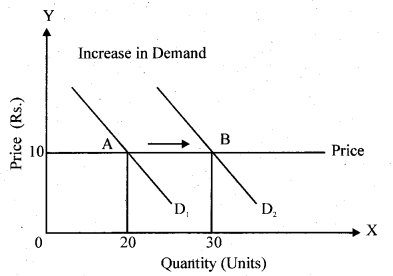
When price of the commodity is ₹ 10 per unit, 20 units are demanded. Even when price remains constant, consumers continue demanding 30 units. It may be due to more alternative uses of a commodity or other such variables. It shows that when the price remains constant, the demand of commodity increases.
Question 11.
What are the important causes of increase in demand?
Answer:
Important causes of increase in demand are the following:
- When income of the consumer increases.
- When price of substitute goods increases.
- When price of complementary goods falls.
- When taste of the consumer shifts in favour of the goods due to change in fashion or climate.
- When price of the commodity is expected to increase in the near future.
- Increase in number of consumers.
- When the income of the consumer is expected to increase in the future.
Question 12.
Describe income effects of the change in price of the commodity.
Answer:
When the price of commodity falls, the consumer can purchase the commodity in excess quantity with his/her income. Or, if he buys a commodity like before, some money will be left with him because he has to spend less due to lower cost. In other words, the actual income or purchasing power of the consumer increases as a result of the fall in the price of a commodity. This increase in real income inspires the consumer to buy more of that commodity. It is called the Income Effect of the Change in the price of the commodity.
Question 13.
Describe substitute effects of the change in price of the commodity.
Answer:
Another important reason is that the price of the item falls due to the demand of the commodity. Choice effect is when the price of a commodity falls, it becomes relatively cheap compared to other items. It encourages the consumer to buy it in place of that commodity, whose price has remained the same. As a result of this substitute effect, the demand for the commodity whose price has fallen increases. This substitute effect is more important with income return.
Question 14.
What do you understand by individual demand schedule?
Answer:
The individual demand schedule is defined as the quantity of a certain item that a consumer will buy at any time at all possible prices. This indicates that different quantities of the item purchased by a consumer at different prices, at any given time.
Question 15.
What do you understand by market demand schedule?
Answer:
Market demand schedule is one which reflects the total demand of all consumers in the market at different prices of goods. The principle states that when commodity price increases, its market demand drops, it refers to the different quantities of the item that all consumers in the market are ready to buy at different possible prices from time to time.
Question 16.
What are the main characteristics of law of demand?
Answer:
The main characteristics of the Law of Demand are the following:
(i) Inverse Relationship : There is an inverse relationship between the price and quantity of demand, that is, if the price increases, the demand falls, and if the price falls, the demand increases.
(ii) The Demand is a Dependent Variable : Under the law of demand, the price is an independent variable and demand is a dependent variable. Thus, it is the effect of price on demand which is examined, and not the effect of demand on price.
(iii) Other Things Remain the Same : The law of demand assumes that the other things remain the same. In other words, there should be no change in other factors affecting the demand except the price. If, however, any other or more one other factors, say the income, alternative price, consumer taste and preferences, advertising outlets, etc. change, despite the increase in their price, demand may increase or alternatively decrease in demand may be seen in spite of price decline.
Question 17.
State any three causes of a rightward shift of demand curve of a commodity.
Answer:
Three causes of a rightward shift of demand curve of a commodity are:
(i) Law of Diminishing Marginal Utility : Diminishing marginal utility is also responsible for increase in demand for a commodity when its price falls. When a person buys a commodity, he exchanges his money income with the commodity in order to maximize his satisfaction.
(ii) Income Effect : When price of a commodity falls, real income of its consumer increases in terms of this commodity. In other words, his purchasing power increases since he is required to pay less for the purchase. This is called Income Effect.
(iii) Substitution Effect: When price of a commodity falls, it becomes cheaper, while the prices of its substitutes remain constant. In other words, when price of a commodity falls, then its substitutes’ price remains the same, and it becomes relatively expensive. Consequently, rational consumers tend to substitute cheaper goods for costlier ones within the range of normal goods, goods whose demand increases with increase in consumer’s income, other things remaining the same. Therefore, demand for the relatively cheaper commodity increases. The increase in demand on account of this factor is known as Substitution Effect.
Question 18.
State the factors causing decrease in demand.
Answer:
Main factors causing decrease in demand are:
- When income of the consumer falls.
- When price of the substitute good decreases.
- When price of the complementary good increases.
- When taste of the consumer shifts against the commodity due to change in fashion or climate.
- When price of the commodity is expected to decrease in the near future.
- When the income of the consumer is expected to fall in the near future.
Question 19.
What is meant by ‘Ceteris Paribus’ assumptions?
Answer:
The law of demand involves the following ‘Ceteris Paribus’ assumptions:
- Consumer’s income is fixed and stable.
- Tastes and preferences of the consumer remain constant.
- The given price change for the commodity is a normal one, it is not imaginary.
- Prices of other goods like substitutes and complementaries remain constant.
- There is no change in the distribution of the community income and wealth.
- The size of population is unchanged.
- The level of taxation and other fiscal measures undergo no significant changes.
Question 21.
How is the market demand curve derived from the individual demand curves?
Answer:
The quantity demanded by an individual purchaser at a given price is known as Individual Demand whereas the total quantity demanded by all the purchasers together is known as Market Demand. The market demand, i.e. the total demand for a commodity can be calculated by adding the quantities demanded by all the purchasers.
Market demand curve can be drawn by aggregating together individual demand curves. Thus, the demand curve is horizontal summation of individual demand curves.
Question 22.
Explain the determinants of the market demand curve.
Answer:
The determinants of the market demand curve are:
(i) Population : Along with population growth, the demand increases, and it decreases along with population decline. The reason for this is that due to the increase (or decrease) of population size, the number of buyers of the product increases (or decreases), the structure of the population also affects the demand; for example the demand for goods for women increases when population has a larger number of women.
(ii) Distribution of Income : Market demand is also influenced by changes in income distribution in society. If income is evenly distributed, then there will be more demand. If the income is distributed unequally, then the more demand will concentrate with rich people. If a large area of society is poor then due to its low income, the demand of the market will also be reduced.
Question 23.
From the following table, prepare demand schedule for household B, given demand schedule of household A, C and market demand schedule.
| Price (in ₹) | Household A | Household B | Household C |
Market Demand |
| 7 | 8 | – | 11 | 26 |
| 6 | 10 | – | 16 | 36 |
| 5 | 14 | – | 22 | 51 |
| 4 | 19 | – | 30 | 71 |
| 3 | 26 | – | 42 | 98 |
Answer:
Household B’s Demand Schedule
| Price (in ₹) | Quantity |
| 7 | 26 – (8 +11) = 7 |
| 6 | 36 – (10 + 16) = 10 |
| 5 | 51 – (14 + 22) = 15 |
| 4 | 71 – (19 + 30) = 22 |
| 3 | 98 – (26 + 42) = 30 |
Question 24.
Demand schedule for three consumers such as Ram, Rahim and Rehmat for a commodity is given below. Derive the market demand schedule.
| Price (in ₹) | Demand Schedule of Ram | Demand Schedule of Rahim | Demand Schedule of Rehmat |
| 1 | 65 | 60 | 29 |
| 2 | 55 | 45 | 18 |
| 3 | 45 | 30 | 10 |
| 4 | 35 | 15 | 5 |
| 5 | 25 | 5 | 5 |
Answer:
Market Demand Schedule
| Price (in ₹) | Quantity |
| 1 | 65 + 60 + 29 = 154 |
| 2 | 55 + 45 + 18 = 118 |
| 3 | 45 + 30 + 10 = 85 |
| 4 | 35 + 15 + 05 = 55 |
| 5 | 25 + 05 + 05 = 35 |
Question 25.
What is cross demand?
Answer:
Cross demand refers to the various amounts of other goods which will be purchased at various prices when the price of a certain goods increases or decreases. These related goods are either substitutes or complementary goods. If they are substitutes, then obviously they satisfy the same want. The more the consumer buys of one, the less he requires the other. For example, tea and coffee are good substitutes. If the price of tea rises, the consumers may buy less of it. Thus, a rise in the price of tea increases the demand for coffee.
A fall in the price of tea, on the contrary, may reduce the demand for coffee because the consumer will now increase his intake of tea. Thus, a change in price of tea effects the demand for coffee. On the contrary, if both the commodities are jointly demanded to satisfy the same want they may be said to be complementary. For example, bread and butter are complementary goods. A fall in the price of bread will increase the demand for butter and vice-versa.
Question 26.
What is income demand?
Answer:
Income demand refers to the various quantity of a goods which consumers will purchase at different levels of income. It assumes that other things such as the price of the commodity as well as the prices of related goods and taste of consumer remain constant. Income demand brings out the relationship between various levels of income and amounts demanded. Demand for certain goods increases with an increase in income. These goods may be considered as superior or luxury goods.
Question 27.
What are the reasons of shift in demand curve?
Or
Distinguish between decrease in demand or left shift curve and increase in demand or right shift curve.
Answer:
The main reason for change in demand is shown in the following table:
| Decrease in Demand or Left Shift Curve | Increase in Demand or Right Shift Curve |
|
Income declines, for normal goods. Income increases, for inferior goods. |
Income rises, for normal goods. Income falls, for inferior goods. Complementary goods’ prices decrease. Tastes and preferences change positively. |
| Buyers quantity decreases. Substitute goods’ price falls. Expectation of income or price falls. |
Quantity of buyers increases. Substitute goods’ price increases. Income or price expectation rises. |
RBSE Class 12 Economics Chapter 3 Long Answer Type Questions
Question 1.
Briefly describe market demand and state the factors that affect market demand.
Answer:
Market demand for a commodity is a sum of all the individuals’ demands for the commodity at a given price per unit of time. Suppose there are only 3 consumers A, B and C of Pepsi and their weekly individual demand for Pepsi at its different prices is given as in table. The last column of the table shows the market demand as derived from the aggregate of individual demands for Pepsi.
| Price (in ₹) | No. of Pepsi Cans Demanded by | Market Demand = A + B + C | ||
| A | B | C | ||
| 12 | 0 | 0 | 0 | 0 |
| 10 | 0 | 0 | 4 | 4 |
| 8 | 0 | 4 | 8 | 12 |
| 6 | 3 | 8 | 12 | 23 |
| 4 | 5 | 12 | 16 | 33 |
| 2 | 8 | 16 | 20 | 44 |
| 0 | 11 | 20 | 24 | 55 |
The last column of table shows weekly market demand for Pepsi. The market demand curve can be obtained by plotting the data in the last column of the table.
Graphical Derivation : Alternatively, market demand curve can be derived graphically by horizontal summation of the individual demand curve at each price of Pepsi. Graphical derivation of the market demand curve is illustrated in the figure given below. The individual demand curves of buyers A, B and C are shown by the demand curves DA, DB and DC respectively. Horizontal summation of these demand curves produces weekly market demand curve for Pepsi as shown by the curve DM.
Thus, a market curve is horizontal summation of individual demand curves at different prices.
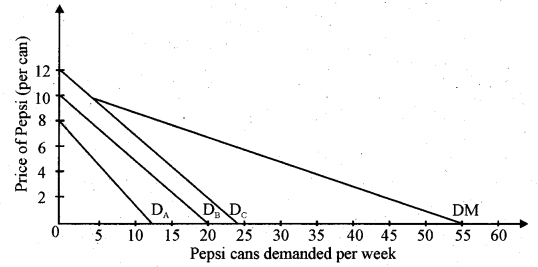
Some important determinants of market demand are as given below :
(i) Price of Substitutes and Complementary Goods : The demand for a commodity depends also on the prices of its substitute and complementary goods. Two commodities are considered as substitutes for one another, if change in price of one affects the demand for the other in the same direction. For example, commodity X and Y are in economic sense substitute for one another if a rise in the price of X increases the demand for Y and vice-versa. Commodity is deemed to be a complement of another when it encourages the use of the other. For example, petrol is a complement to motor vehicles; butter and jam are complements to bread; milk and sugar are compliments to tea and coffee and so on.
(ii) Consumer’s Income and Engle Curves : Consumer’s income is a fundamental determinant of the quantity demanded of a product. It is common belief that the people with the higher disposable income spend huge amounts on goods and services compared to low-income people. Income-demand relationship between demand and its other determinants is of another diverse nature. For the purpose of goods and services of income-demand analysis, it can be grouped under four broad categories, such as:
(a) Essential Consumer Goods : The goods and services in this category are essentially consumed by almost all persons of a society, e.g., food, grains, clothes, vegetable oils, sugars, matches, cooking fuel and housing, etc.
(b) Inferior Goods : Inferior and superior goods are commonly known to both consumers and sellers.
(c) Normal Goods : In economics sense, normal goods are those which are demanded in increasing quantities as consumers’ income rises.
(d) Prestigious Goods : Prestigious goods are those which are consumed mostly by the rich section of the society, e.g. precious stones, studded jewellery, costly cosmetics, luxury cars, air conditioners, costly decorations, etc.
(iii) Consumer’s Taste and Preferences : When there is a change in consumers’ interest, taste and preferences for certain goods and services following the change in fashion, people switch their consumption pattern from cheaper and old fashioned goods over to costlier ‘mod’ goods, so long as price differentials commensurate with their preferences.
(iv) Expected Utility at Equilibrium : A consumer maximizes his total satisfaction or his total utility when marginal utility per unit of expenditure derived from each commodity is the same.
(v) Consumer’s Expectations : If consumers expect a rise in the price of a commodity, they would buy more of it at its current price, with a view to avoiding the pinch of price rise in future. On the contrary, if consumers expect prices of certain goods to fall, they postpone their purchases of such goods with a view to taking advantage of lower prices in future, mainly in case -of non-essential goods. This behaviour of consumers reduces (or increases) the demand in future. Similarly, an expected increase in income on account of the announcement of revision of pay-scales, dearness allowance, bonus, etc. induces increase in current purchase and vice-versa.
(vi) Demonstration Effect : When new commodities or new models of existing ones appear in the market, rich people buy them first. Some people buy new goods or new model of goods because they have genuine need for them, while others buy because they want to exhibit their affluence. But once new commodities come in vogue, many households buy them, not because they have a genuine need for them, but because others or neighbours have bought these goods. Purchase made on account of these variables are the result of ‘demonstration effect’ or the ‘bandwagon effect.’ These effects have a positive effect on the demand.
(vii)Consumer Credit Facility : Availability of credit to the consumers from the sellers, banks, relations and friends or from any other source, encourages the consumers to buy more than that what they would buy in the partial or complete absence of such credit. Credit facility affects mostly the demand for consumer durables, particularly those which require bulk payment at the time of purchase.
(viii) Population of the Country : The total domestic demand for a product depends also on the size of population. Given the price, per capita income, taste and preferences etc. the larger the population, the larger the demand for a product of common use. With an increase (or decrease) in the size of population, employment percentage remaining the same, demand for the product increases (or decreases). The relation between market demand for a product (normal) and the size of population is similar to the income-demand relationship.
(ix) Distribution of National income : The distribution pattern of national income also affects the demand for a commodity. If national income is evenly distributed, market demand for normal goods will be the largest. If national income is unevenly distributed, i.e., if majority of population belongs to the lower income groups, market demand for essential goods will be the largest, whereas the same for other kinds of goods will be relatively low.
Question 2.
Distinguish between individual demand and market demand.
Answer:
(i) Individual Demand : The quantity of the commodity demanded by an individual customer at a given time and given price is known as Individual Demand. Individual demand is a graphical presentation of an individual demand schedule. The curve, which shows the relationship between the price of an item and the quantity of the item that the consumer wants to buy, is called the Demand Curve. Individual demand curve slopes downwards from left to right. The following diagram shows the individual demand curve:
| Price (in dollars) | Demand (in kilograms) |
| 5 | 5 |
| 4 | 10 |
| 3 | 15 |
| 2 | 20 |
(ii) Market Demand : The sum total of individual demands is known as Market Demand. Market demand schedule means ‘the amount of a given commodity, which all the consumers want to buy at any point of time at all possible prices’. Demand schedule of all individuals can be added to find market demand schedule. The following table shows market demand schedule :
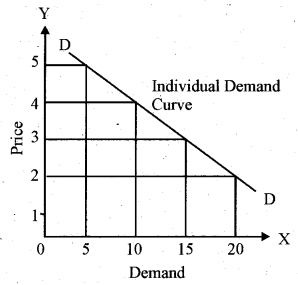
| Price in dollars | Demand of Individual ‘A’ | Demand of Individual ‘B’ | Demand of Individual ‘C’ | Demand of Individual A+B+C |
| 5 | 20 | 30 | 50 | 100 |
| 4 | 40 | 60 | 100 | 200 |
| 3 | 60 | 90 | 150 | 300 |
| 2 | 80 | 120 | 200 | 400 |
Demand scheduling can be presented graphically. Graph of demand shade is called Demand Curve. It shows the maximum amount per unit that all consumers buy at different prices. The following diagram shows the market demand curve:
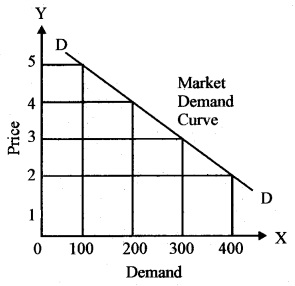
The diagram shows that when the price is ₹ 5, then the market demand is 100 kilograms. When the price is ₹ 4, then the demand is 200 kilograms. When the price is fixed at ₹ 3, then the demand is 300 kilograms, When the price is ₹ 2, then the demand increases to. 400 kg that means there is an inverse relationship between demand for goods and their price. When price decreases, the market demand for goods increases and vice-versa.
Question 3.
Distinguish between extension of demand and increase in demand with the help of diagram.
Answer:
Difference between extension of demand and increase in demand :
| S.No. | Basis of Difference | Extension of Demand | Increase in Demand |
| 1. | Meaning | It is increase in demand due to fall in price when other things remain same. | It is rise in demand due to change in variables other than the price of the commodity. |
| 2. | Demand schedule | There is a single demand schedule. | There is more than one demand schedule. |
| 3. | Movement of the curve | The demand curve moves downward. | The demand curve shifts towards right. |
| 4. | Causes | Decline in price. | Due to rise in income, increase in price of substitute goods and change in taste, increase etc. |
| 5. | Examples | It will be a case of extension of demand if by fall in the price of commodity from ₹ 5 to ₹ 1, the demand increases from 1 unit to 5 units. | It will be a case of increase in demand if the price remains stable at ₹ 3 per unit but the demand increases from 3 units to 4 units. It may also happen that the price may increase from ₹ 3 to ₹ 4 but the demand remains constant at 3 units. |
Question 4.
Explain the factors which determine demand for a commodity.
Answer:
The factors which determine demand for a commodity are the following:
(i) Tastes and Preferences: The demand of any commodity also depends on the taste and preferences of consumers, and changes from time to time. Things which are more in fashion, are more in demand than those that are out of fashion. Consumers can also leave the baggage before their being fully utilized and prefer other accessories in fashion. For example, colour television is more in demand and more and more people are leaving their black and white television, even if they can use it for a few more years.
(ii) Price of the Commodity : Ceteris Paribus i.e., other things being the same, the demand of a commodity is inversely propertional to its price, which means that the increase in the price of a commodity decreases its purchases and vice-versa. This is due to income and substitution effect.
(iii) Price of Related Goods: Complementary goods are those goods that are consumed together or simultaneously. For example, tea and sugar, automobiles and petrol, pen and ink are used together. When commodities are complements, a fall in the price of one (other things being equal) will cause the demand of the other to rise. For example, a fall in the price of cars would lead to a rise in the demand for petrol. Similarly, a fall in the price of pens, will cause a rise in the demand for ink. The reverse will be the case when the price of a complement rises.
Substitute goods are those goods which can be used easily in place of one another. For example, tea and coffee, ink pen and ball pen, are substitutes for each other and can be used in place of one another easily. When goods are substitutes, a fall in the price of one (Ceteris Paribus) leads to a fall in the quantity demanded of its substitutes. For example, if the price of tea falls, people will try to substitute it for coffee and demand more of it and less of coffee, i.e., the demand for tea will rise and that of coffee will fall.
(iv) Level of Income of the Household : Other things being equal, the demand for a commodity depends upon the money income sf the household. In most cases, the larger the average money income of the household, the larger is the quantity demanded of a particular good. However, there are certain commodities for which quantities demanded decrease with an increase in money income.
These goods are called Inferior Goods. Even in the case of other goods, the response of quantities demanded to changes in their prices is not of same proportions. If goods are such that they satisfy the basic necessity (food, clothing, shelter) of life, a change in their prices although will cause an increase in demand for these necessities this increase will be less than proportionate to the increase in income, as compared to other non-durable goods in the overall consumption pattern and a rise in importance of durable goods such as a TV, car, house, etc.